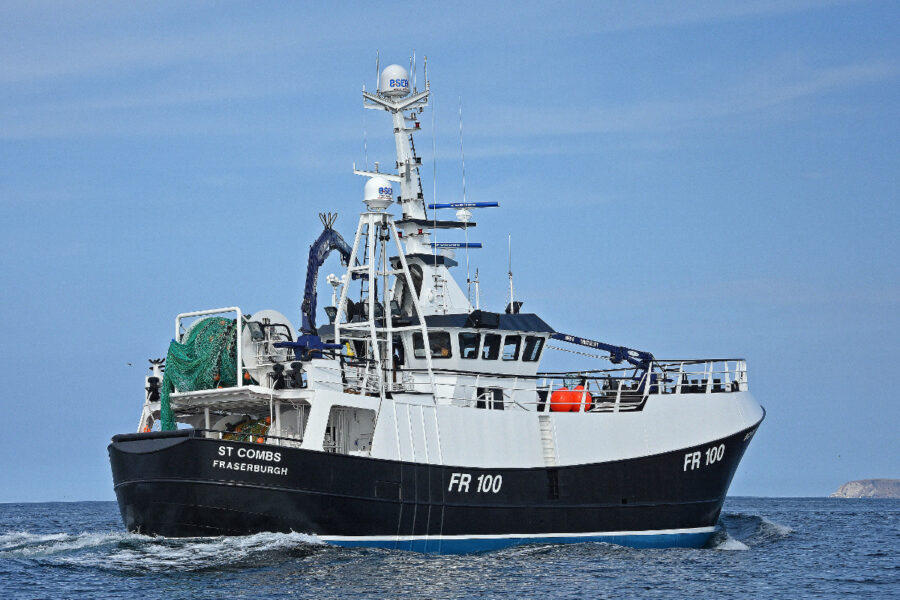Designed and built at Macduff for St Combs skipper Bruce Buchan, the new 24m dedicated fly-shooter Achieve FR 100 combines well-proven seine-netting principles with modern technology – more from yesterday’s feature…
Thistle Marine and Scantrol iSYM auto-fly-shooting
Two large-capacity self-hauling rope reels, manufactured by Thistle Marine and operating through a Scantrol iSYM computerised system, are at the centre of shooting and hauling activities on Achieve.
Thistle Marine designed Achieve’s integrated hydraulic system around the specific requirements of the self-hauling rope reels, in conjunction with SM Electrical. Incorporating HPU monitoring, the bespoke system includes a temperature sensor with auto-start for cooling, together with low oil warning and shutdown on the hydraulic oil tank.
With a core pull-rating of 15t, and a working capacity of 4,500m of 38mm-diameter four-strand combination seine-net rope, the self-hauling reels are fitted with Hägglunds direct-drive motors to give optimum levels of operational efficiency and a maximum drum speed of 150rpm.
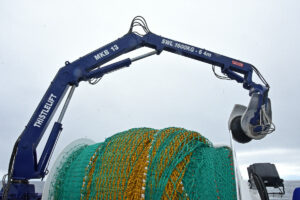
A Thistlelift MKB13 crane and power block is mounted on the starboard side of the shelterdeck aft.
Featuring electro-hydraulic spooling, the self-hauling rope reels also incorporate a freewheel function for running off the ropes at up to 150rpm. A hydrostatic braking system operated by dedicated hydraulic pumps is fitted to each reel to prevent the rope from jumping during shooting.
Operating in conjunction with a Scantrol iSYM auto-seine net system, the reels enable skipper Bruce Buchan to control all aspects of the shooting and hauling process either from a master display screen in the main forward console, or aft at the fishing console. The interlinked control panels, which include joysticks for the main deck machinery and the bow thruster, were designed, built and installed by Steve Mckay of SM Electrical. The Fochabers-based electrical and automation engineers represent Scantrol in the UK.
The iSYM auto-seine system provides a constant display of hauling speed, hydraulic pressure, tension, rope length, and the differential between port and starboard warps. When the selected differential is exceeded, the reel on the longer side is automatically slowed down in order to keep the port and starboard ropes level in the water astern, before reverting to the chosen rate. The system also caters for four modes of operation – towing, stopped, heaving and shooting.
Fifteen coils of 38mm-diameter seine-net ropes are usually run off at up to 300m per minute. This equates to one side of rope being shot in just 12 minutes.
On picking up the dahn, the preferred towing mode is selected – usually constant drum speed in rpm.
In this mode, the rate of heave gradually increases as the core diameter of rope on the drum builds up, from a core diameter of 270mm. For the first coil, with the reels turning at 12rpm, the ropes are heaved at a rate of 15-20m per minute, slowly increasing towards 55m/min.
When the ropes close up, heave mode is employed, typically with around 1,500m of rope on the reels, before the last few coils come in at up to 200m per minute.
The self-hauling reels are positioned side by side on the main deck forward of the fishroom hatch. The heavy-duty guiding-on gear is mounted at the top of the reels, which have an outer flange diameter of 2.5m. From the guiding-on gear, the ropes have a shallow lead to full-width rollers positioned across the lower edge of hatches incorporated into the end of the raised forward section of the shelterdeck. The ropes are then led either side of the wheelhouse by deck-mounted rollers, to one of two sets of pendulum hanging blocks mounted aft on either side of the shelterdeck.

Thistle Marine engineers Alec Hay (left) and Nathan Bruce provide a scale perspective for Achieve’s self-hauling power reels.
The self-hauling rope reels, together with the remaining balance of Achieve’s deck machinery, are driven from two sets of Dennison constant disarmament pumps via a Centra Drive unit off the Cummins QSL9 variable-speed auxiliary engine. A similar clutched arrangement, driven off the forward end of the main engine, can be used for gear retrieval purposes should the need arise.
Two 22kW electro-hydraulic packs in the engineroom operate the remote pilot control valves fitted to all the deck equipment and the hydraulic spooling gear on the self-hauling rope reels.
Thistle Marine also supplied a Dinamic S45 5t Gilson winch mounted on the shelterdeck inboard of the square-framed lifting gantry, in the traditional location abaft the wheelhouse favoured by Scottish seine-netters.
A Thistlelift MKB13 short-post kinked-boom crane c/w Thistle 24in power block is stepped on a raised platform on the starboard side of the shelterdeck aft. The elevated position provides the crewman operating the crane to lift out the ground gear and pick up the bag, with an excellent line of vision.
At the end of a trip, catches are swung ashore by a Thistle Marine MFB8 stiff-boom crane served by a 2t landing winch.
Macduff Shipyards manufactured the two sets of 2 x 10t split net drums positioned directly above each other at the stern, and a 4t anchor windlass.
Third Achieve for St Combs family
The new Achieve continues a proud family tradition stretching back 46 years, and two other seine-net boats of the same name.
Having initially gone to sea on the local dual-purpose motor drifter/seine-netter Dayspring FR 120, skipper Andrew Buchan took delivery of the 80ft fly-shooter Achieve in 1972 when he was only 26 years old.
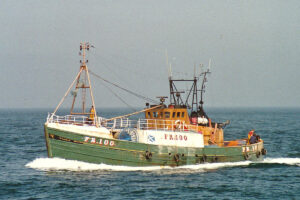
Irvin’s of Peterhead built the first Achieve in 1972.
Featuring a traditional cruiser stern, Achieve had main dimensions of LOA 24.36m (79ft 11in), registered length 23.16m (75ft 10in), beam 6.86m (22ft 6in) and depth 3.26m (10ft 8in).
As was customary for Richard Irvin, Achieve was built for skipper Andrew Buchan at the same time as her sister vessel Ulysses PD 76 was being framed (oak) and planked (larch) in the same building for Peterhead skipper Andrew Reid. As well as being double-framed, the identical hulls also featured steel beams, bulkheads and engine bearers for
optimum strength, in addition to steel deckhouses.
Achieve was open-decked apart from a whaleback under which a Jensen seine winch and Beccles coiler were fitted. On being coiled, the seine-net ropes were laid along the vessel’s side decks amidships in the traditional manner. Achieve was subsequently fitted with rope bins, before hydraulically-driven storage reels were fitted.
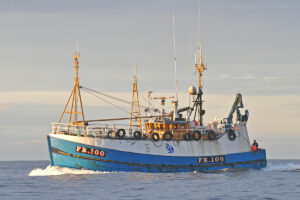
The second Achieve was launched by Herd & Mackenzie in 1984 as Bunillidh WY 96, and renamed in 1999.
Achieve was equipped with a 450hp Caterpillar main engine coupled to a Reintjes 3:1 reduction gearbox. A Lister auxiliary engine was also fitted. The vessel’s hydraulic system was driven off the fore end of the propulsion unit through a Norgear step-up box. Six hundred boxes could be carried in the fishroom, together with 12t of ice.
After giving 27 years of consistently successful service, during which time a gutting shelter was fitted amidships and a new Caterpillar D353 engine installed in 1994, the first Achieve was replaced in 1999 with the 19.3m seine-netter Bunillidh WK 96, which the owners bought from David Cowie of Helmsdale and immediately renamed Achieve FR 100.
The original Achieve was sold to former Peterhead fisherman Alex Wood, who converted the seiner into the luxury charter vessel Scotia W. On completion of a long-term refurbishment project, Scotia W was officially named by Scotland’s First Minister, the Rt Hon Alex Salmond MSP, in November 2011, since when the boat has operated predominately in the Moray Firth, along the Caledonian Canal, and around Scotland’s west coast.
The second Achieve was built by Herd & Mackenzie at Buckie in 1984 as the wooden-hulled three-quarter-shelterdecked Bunillidh for David Cowie. Taking its name from the Scottish Gaelic name for the Sutherland fishing village of Helmsdale, Bunillidh regularly landed into Kinlochbervie, Scrabster and Wick when working the traditional seine-net grounds across the top of Scotland, as well as into Peterhead when fishing eastward.
Skipper Andrew Buchan fished Achieve for 15 years, before he stepped ashore in 2014, when Bruce Buchan took over wheelhouse duties on the family boat, which was renamed Bunillidh FR 104 when her successor was nearing completion at Macduff.
Jackson Trawls
Peterhead netmaker Jackson Trawls continued its long-standing relationship with St Combs skipper Bruce Buchan by making three different types of seine nets and supplying the full package of fishing gear and chandlery now being used on Achieve.
For taking fish off harder bottom and ground edges, Bruce Buchan and Achieve’s crew use a four-section box hopper seine. This net has 555 x 8in meshes in the fishing circle and is built with 3.1mm Sapphire twine. The 250ft of groundgear consists of two 45ft lengths of rubber legs either side of 160 10in- and 12in-diameter hoppers.
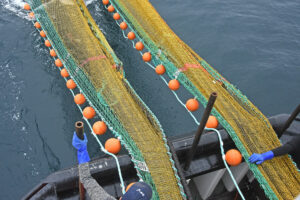
The shadier ground hopper seine was one of three nets Jackson Trawls made for Achieve.
A dual-purpose net with 740 x 8in meshes in the fishing circle rubbers is used when fishing on generally cleaner ground. Of lighter construction, this combi-seine is made with 3mm-diameter Euroline netting and set on 5in- and 6in-diameter discs.
Both nets, which give a headline height of around six fathoms, are rigged with 8in heavy-duty floats. These are attached to an 18mm Dyneema double headline that keeps the floats in line, thereby helping to prevent the wings fouling when being shot together trawl-style off the drum, when the wing closest to the boat is pulled clear of the net for a short period of time before starting to run the second side of ropes.
Both nets are fished using 30 fathoms of rubber leg and 18mm combination splits.
Jackson Trawls also made a traditional style of clean ground grassrope seine net for Achieve. With 690 x 8in meshes in the mouth and measuring 286ft on the fishing line, this net is made with 2.1mm-diameter Sapphire twine in the top sections and 3mm in the lower. A small mesh guard is attached to the footrope for taking flatfish.
Jacksons also supplied three 125mm codends, made with Sapphire 5mm double netting, that follow on from 4mm double extension sections.
In the now-standard method of working seine nets on the modern class of fly-shooter, the nets are shot trawl-style off the drum at the same time as the last few coils of rope are running, before the sweeps are clipped into the ends of the ropes. After towing the second wing for 30-40 seconds to open up the mouth of the net, the second side of ropes begin to be shot as the tide continues to open up the mouth of the net.
Achieve FR 100
DETAILS
Owner: Bruce Buchan, Achieve FR 100, St Combs
Designer: Macduff Ship Design Ltd
Boatyard: Macduff Shipyards Ltd
Agent: Westward Fishing Company Ltd, Fraserburgh
DIMENSIONS and CAPACITIES
Length overall: 24m; Length BP: 20.9m; Beam: 7.5m; Depth moulded: 4.20m; Draft: 4.80m; Tonnage: 224 tonnes gross; Fuel: 22,800 litres; Freshwater: 18,300 litres; Lube oil: 500 litres; Hydraulic oil: 500 litres; Fishroom: 800 boxes; 10t ice
ENGINEROOM
Main engine: Caterpillar C32 ACERT of 560kW @ 1,600/1,800rpm driving through a Reintjes WAF 374 7.09:1 reduction gearbox to a 2,100mm-diameter four-bladed Kort propeller. Speed: 10.5 knots
Auxiliary engines: Cummins QSL9 of 260kW @ 1,800rpm driving the main hydraulic pumps through a Centra Drive; 2 x Beta Marine 81.6kW 415/3/50 generators based on Cummins 6BT5.9D2 (M) engines and Mecc Alte generators
Bow thruster: Hardy Engineering 112kW
Fuel/oil filters/separators: CC Jensen
Bilge/deckwash, deck sump, cooling pumps: Bombas Azcue SA electrically-driven
DECK MACHINERY
Suppliers: Thistle Marine, Peterhead and Macduff Shipyards.
2 x SHR15 self-hauling rope reels; two 2 x 10t split net drums (Macduff Shipyards); Dinamic S45 Gilson winch (5t); Anchor windlass (4t) (Macduff Shipyards); Thistle MKB13 kinked-boom short-post crane SWL 1600kg 5.5m and Thistle 24in powerblock; Thistle MFB8 SWL 1000kg 8m straight-boom landing crane c/w Thistle landing winch (2t)
FISH HANDLING/FISHROOM
Fish-handling system: Macduff Shipyards Ltd; Fishroom chilling: Premier Refrigeration, Fraserburgh; Ice machines: 2 x Geneglace 2.5t
ELECTRONICS
Suppliers: Woodsons and Furuno UK
Fish detection
Simrad ES80 split-beam echosounder (50kHz); Kaijo KSE300 split-beam echosounder (50kHz)
Navigation
Furuno FAR 2827 and FAR 1518 BB radars; 2 x Furuno GP 39 GPS receivers; 2 x Sodena Easywin plotting systems c/w AIS, ARPA and hi-res seafloor charts; Fishsafe unit; Navitron NT 921 MKII autopilot c/w NT 990FU follow-up lever and NT920 digital heading repeater; JRC JLR 21 GPS satellite compass; Airmar 220WX weather station; AIS dahn buoy system
Communications
JRC JSS-2150 150W GMDSS HF SSB radio telephone; Sailor 6215 DSC VHF; 2 x Sailor 6210 VHFs; Entel HT649 handheld GMDSS VHF; Easy Navtex; Jotron TR-8000 Class A AIS; Phontech 3100 five-way talkback system; Jotron TRON 60GPS; e-Sea 60Ka internet communications system; e-Sea 60 satellite TV system; Pietel GSM phone; VCU catch-management system; CCTV system c/w 16 cameras
FISHING GEAR
Supplier: Jackson Trawls, Peterhead. Nets: 1 x hopper seine with 555 x 8in meshes in fishing circle rigged on 160ft of 10in- and 12in-diameter hoppers and 2 x 45ft of rubber legs; 1 x 740 x 8in-mesh dual-purpose net set of 5in- and 6in-diameter discs; 1 x traditional grassrope seine net with 690 x 8in in the mouth and 286ft on fishing line; Seine net rope – Jackson Trawls/VCU 30 coils of 38mm-diameter four-strand combination
ACCOMMODATION
1 x eight-berth cabin
GENERAL
Engine controls: Three-station, Helmsman Systems Ltd; Insurance: Sunderland Marine; Lifesaving appliances: Blue Anchor Fire & Safety, Fraserburgh; Paint: International; Steering: MT1000 Scan Aps, Hvide Sande, Denmark; Wheelhouse seats: 2 x NorSap; Wheelhouse windows: HK Van Wingerden & Zn BV, Holland; Wipers: Wynn

